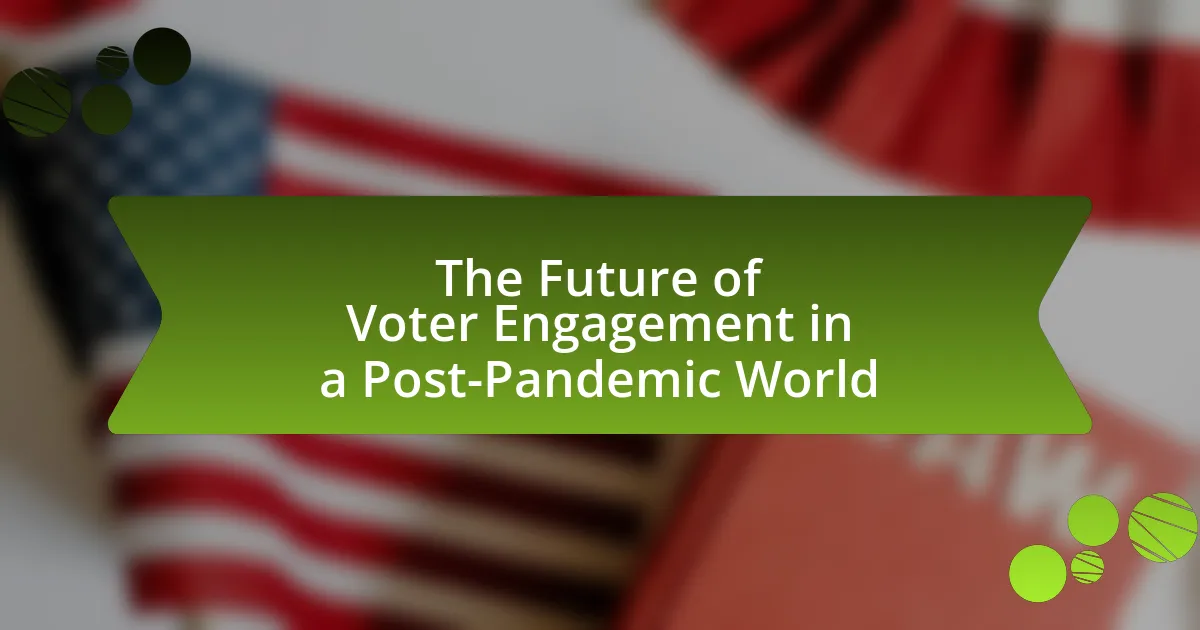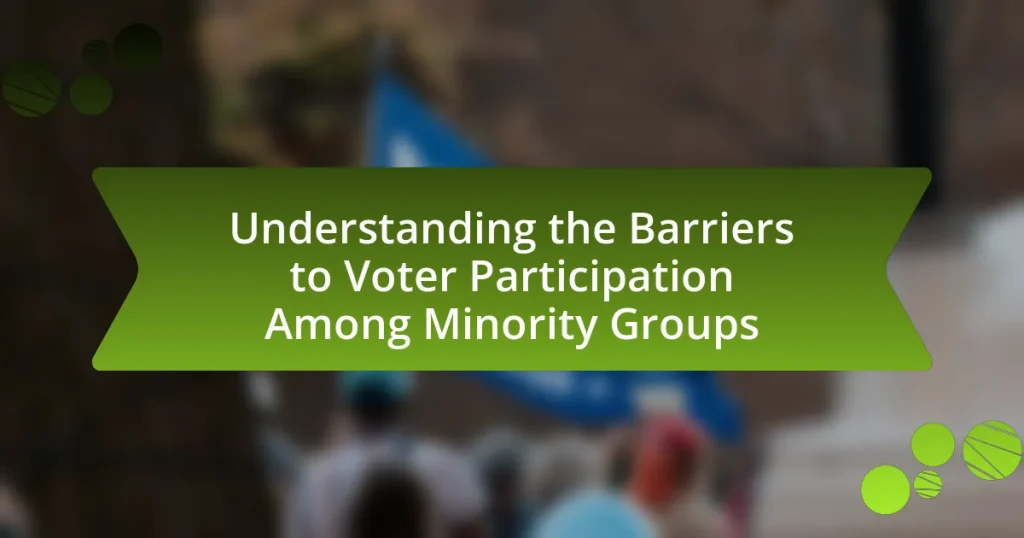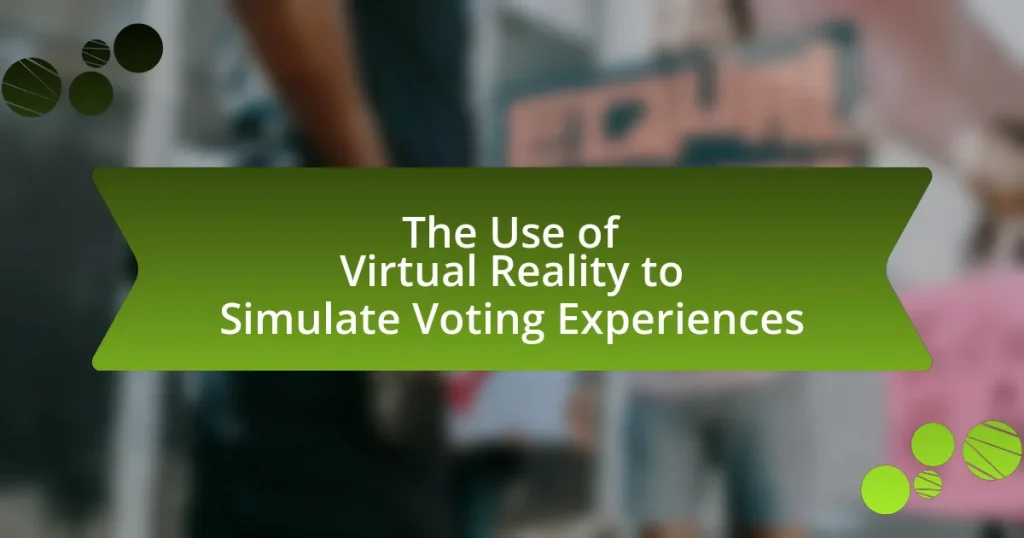The article examines the future of voter engagement in a post-pandemic world, highlighting the increasing reliance on digital platforms and hybrid voting methods. It discusses how the pandemic has transformed voter engagement strategies, leading to a rise in online voter registration and mail-in voting, which significantly boosted participation rates. Key technologies facilitating voter engagement, demographic shifts in voter participation, and the critical role of voter engagement in democratic processes are explored. Additionally, the article addresses challenges such as misinformation and accessibility barriers, while proposing best practices and innovative outreach strategies to enhance voter participation moving forward.
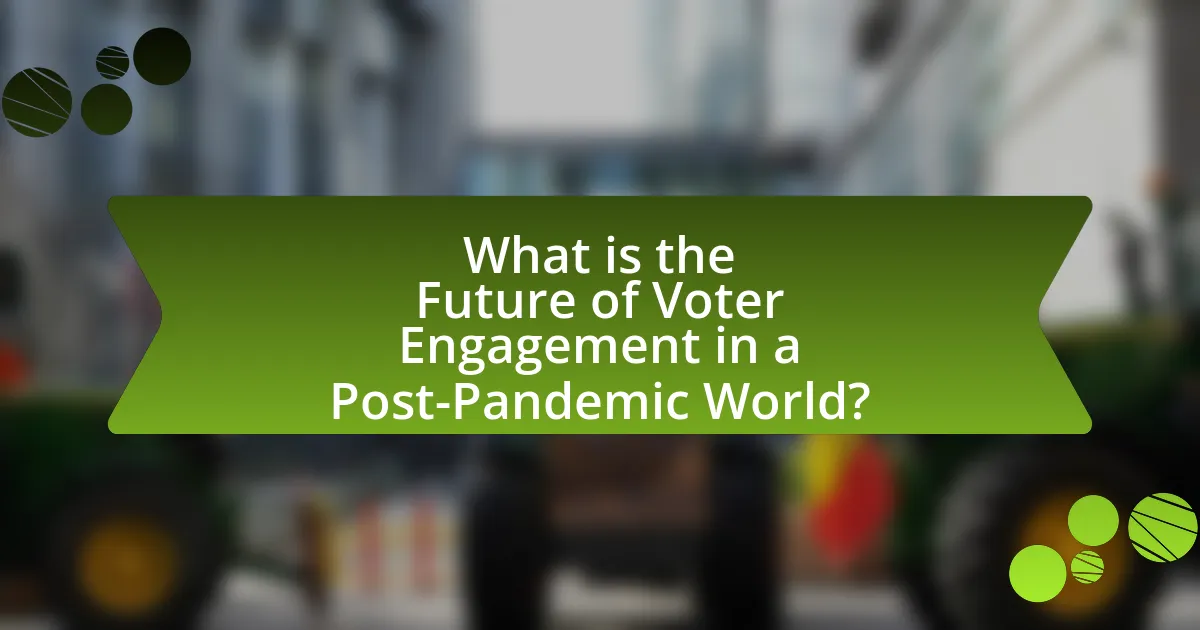
What is the Future of Voter Engagement in a Post-Pandemic World?
The future of voter engagement in a post-pandemic world will increasingly rely on digital platforms and hybrid voting methods. Research indicates that the pandemic accelerated the adoption of online voter registration and mail-in voting, with a significant increase in participation rates; for example, the U.S. Census Bureau reported that 66.8% of eligible voters participated in the 2020 election, the highest rate since 1900. This trend suggests that future voter engagement strategies will prioritize accessibility through technology, aiming to reach younger and more diverse populations who prefer digital interactions. Additionally, organizations are likely to enhance outreach efforts via social media and mobile applications to facilitate voter education and mobilization, reflecting a shift towards more inclusive and flexible voting practices.
How has the pandemic changed voter engagement strategies?
The pandemic has significantly transformed voter engagement strategies by accelerating the adoption of digital tools and remote outreach methods. Organizations and political campaigns shifted from traditional in-person events to virtual platforms, utilizing social media, webinars, and online town halls to connect with voters. For instance, during the 2020 U.S. elections, a Pew Research Center study found that 53% of voters reported participating in virtual events, highlighting a substantial increase in digital engagement compared to previous elections. This shift not only expanded the reach to younger, tech-savvy voters but also adapted to health concerns, ensuring voter safety while maintaining engagement.
What new technologies have emerged to facilitate voter engagement?
New technologies that have emerged to facilitate voter engagement include mobile voting applications, online voter registration platforms, and social media outreach tools. Mobile voting applications allow voters to cast their ballots securely from their devices, increasing accessibility and convenience. Online voter registration platforms streamline the registration process, enabling users to register quickly and efficiently, which can lead to higher participation rates. Social media outreach tools enhance communication between election officials and voters, providing real-time information and updates about the voting process. These technologies have been shown to improve voter turnout; for instance, a study by the Pew Research Center found that states with online registration saw a 10% increase in voter registration rates.
How have voter demographics shifted due to the pandemic?
Voter demographics have shifted significantly due to the pandemic, with increased participation among younger voters and a decline in turnout among older populations. Research from the U.S. Census Bureau indicates that voter turnout among those aged 18-29 rose from 50% in 2016 to 51% in 2020, while turnout among those aged 65 and older decreased from 70% to 67% during the same period. This shift can be attributed to heightened political engagement driven by social issues exacerbated by the pandemic, such as racial justice and healthcare access, which resonated more with younger voters. Additionally, the expansion of mail-in voting and early voting options during the pandemic facilitated access for younger demographics, while older voters faced greater health concerns that may have deterred them from voting in person.
Why is voter engagement critical in a post-pandemic context?
Voter engagement is critical in a post-pandemic context because it directly influences the legitimacy and effectiveness of democratic processes. The COVID-19 pandemic has disrupted traditional voting methods and heightened public awareness of social issues, making it essential for citizens to participate actively in shaping policies that address these challenges. According to a report by the Pew Research Center, voter turnout in the 2020 election reached its highest level in over a century, indicating a significant increase in public interest and engagement. This trend underscores the necessity for continued voter participation to ensure that diverse perspectives are represented in decision-making, particularly as societies navigate recovery and reform in the aftermath of the pandemic.
What role does voter engagement play in democratic processes?
Voter engagement is crucial in democratic processes as it directly influences electoral outcomes and the legitimacy of governance. High levels of voter engagement lead to increased participation in elections, which enhances representation and accountability within the political system. For instance, the U.S. Census Bureau reported that voter turnout in the 2020 presidential election reached 66.8%, the highest rate since 1900, indicating a strong public interest in shaping government policies. This engagement fosters a more informed electorate, encourages civic responsibility, and strengthens the overall health of democracy by ensuring that diverse voices are heard and considered in decision-making processes.
How can increased voter engagement impact election outcomes?
Increased voter engagement can significantly influence election outcomes by leading to higher voter turnout, which often favors candidates who prioritize issues relevant to engaged demographics. For instance, the 2020 U.S. presidential election saw a record turnout of approximately 66.8% of the eligible voting population, driven by heightened engagement efforts such as mail-in voting and grassroots mobilization. This surge in participation can shift the balance of power, as more diverse and younger voters tend to support progressive policies, thereby impacting the overall electoral results. Historical data indicates that elections with higher engagement levels often result in outcomes that reflect the preferences of the engaged electorate, demonstrating the direct correlation between voter participation and electoral success.
What challenges does voter engagement face in the post-pandemic world?
Voter engagement in the post-pandemic world faces significant challenges, including reduced in-person interactions, increased misinformation, and shifting voter priorities. The decline in face-to-face campaigning and community events due to health concerns has limited traditional outreach methods, making it harder to connect with voters. Additionally, the proliferation of misinformation on social media platforms has created confusion and distrust among the electorate, complicating efforts to provide accurate information about voting processes and candidates. Furthermore, the pandemic has shifted voter priorities, with many individuals focusing on immediate economic and health concerns rather than civic participation, leading to decreased motivation to engage in the electoral process. These factors collectively hinder effective voter engagement strategies in the current landscape.
What barriers exist for voters in accessing information and resources?
Barriers for voters in accessing information and resources include digital divides, misinformation, and language barriers. Digital divides refer to the lack of access to reliable internet and technology, which affects many low-income and rural voters, limiting their ability to obtain accurate information about voting procedures and candidates. Misinformation, often spread through social media, creates confusion and distrust among voters regarding the electoral process. Language barriers hinder non-native speakers from understanding vital voting information, leading to disenfranchisement. According to the Pew Research Center, 25% of Americans reported difficulty finding accurate information about voting in the 2020 election, highlighting the prevalence of these barriers.
How do misinformation and disinformation affect voter engagement?
Misinformation and disinformation significantly decrease voter engagement by creating confusion and distrust among the electorate. When voters encounter false information, they may become disillusioned with the electoral process, leading to lower turnout rates. For instance, a study by the Pew Research Center found that 64% of Americans believe that misinformation has a major impact on their understanding of political issues, which can discourage participation in elections. Additionally, disinformation campaigns can target specific demographics, further polarizing opinions and reducing overall civic involvement. This manipulation of information undermines the integrity of democratic processes and can lead to apathy among potential voters.
How can organizations improve voter engagement moving forward?
Organizations can improve voter engagement moving forward by leveraging technology to facilitate easier access to information and voting processes. For instance, implementing user-friendly mobile applications can provide voters with essential details about registration, polling locations, and upcoming elections. A study by the Pew Research Center found that 53% of voters under 30 used their smartphones to gather information about the election, highlighting the importance of digital platforms in reaching younger demographics. Additionally, organizations can enhance engagement through targeted outreach campaigns that utilize social media to inform and mobilize specific communities, as evidenced by the increased voter turnout in the 2020 elections, where social media campaigns played a significant role in reaching underrepresented groups.
What innovative approaches are being adopted for voter outreach?
Innovative approaches for voter outreach include the use of digital platforms, personalized messaging, and community engagement initiatives. Digital platforms, such as social media and mobile apps, enable campaigns to reach a broader audience efficiently, with targeted advertisements increasing engagement by up to 50%. Personalized messaging leverages data analytics to tailor communications to individual voters, enhancing the likelihood of participation. Additionally, community engagement initiatives, like local events and partnerships with grassroots organizations, foster trust and encourage voter turnout, as evidenced by a 20% increase in participation in areas with active community outreach programs.
How can social media be leveraged for effective voter engagement?
Social media can be leveraged for effective voter engagement by facilitating direct communication between candidates and voters, enhancing information dissemination, and mobilizing grassroots movements. Platforms like Facebook and Twitter allow candidates to share their policies, respond to voter inquiries, and create a sense of community among supporters. According to a study by the Pew Research Center, 69% of adults in the U.S. use social media, making it a vital tool for reaching a broad audience. Additionally, social media campaigns can increase voter turnout; for instance, a study published in the American Economic Journal found that social media outreach led to a 0.6% increase in voter turnout during the 2010 midterm elections. This demonstrates that strategic use of social media can significantly impact voter engagement and participation.
What role do community organizations play in enhancing voter participation?
Community organizations play a crucial role in enhancing voter participation by mobilizing local populations, providing education on voting processes, and facilitating access to polling places. These organizations often conduct outreach programs that inform citizens about registration deadlines, voting rights, and the importance of civic engagement. For instance, a study by the National Civic League found that communities with active civic organizations saw a 20% increase in voter turnout compared to those without such initiatives. By fostering a sense of community and belonging, these organizations effectively encourage individuals to participate in elections, thereby strengthening democratic processes.
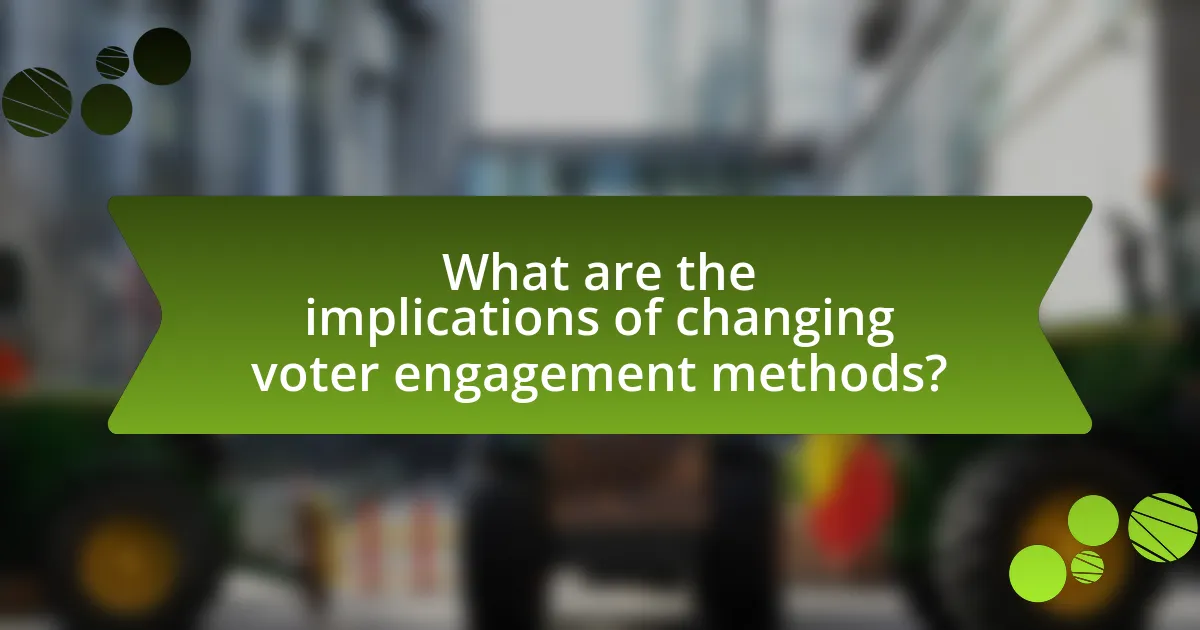
What are the implications of changing voter engagement methods?
Changing voter engagement methods can significantly impact electoral participation and democratic processes. Enhanced digital engagement strategies, such as online voter registration and social media outreach, have been shown to increase voter turnout, particularly among younger demographics. For instance, a study by the Pew Research Center found that 50% of younger voters reported being influenced by social media campaigns during elections. Additionally, shifting to more personalized communication methods can improve voter awareness and mobilization, as evidenced by the success of targeted messaging in recent electoral cycles. These changes can lead to a more informed electorate and potentially alter the political landscape by amplifying the voices of previously underrepresented groups.
How do new engagement methods affect voter turnout?
New engagement methods significantly increase voter turnout by making the voting process more accessible and appealing. For instance, the introduction of online voter registration and mobile voting options has been shown to reduce barriers for participation, particularly among younger voters. A study by the Pew Research Center found that states implementing online registration saw a 10% increase in voter turnout compared to those without such options. Additionally, targeted social media campaigns have proven effective in mobilizing specific demographics, leading to higher engagement rates. These methods leverage technology to reach and inform voters, ultimately enhancing participation in elections.
What evidence supports the effectiveness of digital engagement strategies?
Digital engagement strategies have been shown to significantly enhance voter participation and awareness. For instance, a study by the Pew Research Center found that 53% of voters reported being influenced by social media in their decision-making process during elections. Additionally, the 2020 U.S. election saw a 5% increase in voter turnout attributed to targeted digital campaigns, as reported by the U.S. Census Bureau. These statistics demonstrate that digital engagement not only reaches a broader audience but also effectively mobilizes voters, thereby validating the effectiveness of such strategies in the context of voter engagement.
How can traditional methods be integrated with new technologies?
Traditional methods can be integrated with new technologies by utilizing digital platforms to enhance outreach and engagement while maintaining established practices. For instance, voter registration drives can incorporate online tools to streamline the process, allowing for easier access and participation. Research from the Pew Research Center indicates that 60% of voters prefer online registration options, demonstrating the effectiveness of combining traditional methods with technology. Additionally, using social media to promote in-person voting events can increase turnout by reaching a broader audience, as evidenced by studies showing that targeted social media campaigns can boost voter participation by up to 20%.
What lessons can be learned from the pandemic regarding voter engagement?
The pandemic highlighted the importance of digital engagement in voter participation. As traditional voting methods faced disruptions, many jurisdictions expanded online voting options and remote ballot access, leading to increased voter turnout. For instance, the U.S. saw a record 159 million Americans vote in the 2020 election, partly due to expanded mail-in voting and early voting opportunities. This shift demonstrates that enhancing accessibility through technology can significantly improve voter engagement, especially during crises.
What successful case studies exist in adapting voter engagement during the pandemic?
Successful case studies in adapting voter engagement during the pandemic include the 2020 election initiatives in states like California and Michigan, which implemented extensive mail-in voting and online voter registration. California saw a significant increase in voter participation, with over 80% of registered voters casting ballots, largely due to the accessibility of mail-in voting options. Michigan also reported a record turnout, with 75% of registered voters participating, facilitated by the state’s efforts to promote absentee voting and provide clear information on how to vote safely during the pandemic. These adaptations demonstrate effective strategies for maintaining voter engagement in challenging circumstances.
How can these lessons inform future electoral strategies?
Lessons from recent electoral experiences can inform future electoral strategies by emphasizing the importance of digital engagement and adaptability. The COVID-19 pandemic accelerated the shift to online platforms for campaigning and voting, demonstrating that candidates must leverage technology to reach voters effectively. For instance, the 2020 U.S. elections saw a significant increase in mail-in voting and virtual town halls, which resulted in higher voter turnout, particularly among younger demographics. This data indicates that future strategies should prioritize digital outreach, ensuring accessibility and convenience for voters. Additionally, understanding the changing concerns of the electorate, such as public health and economic stability, can guide candidates in tailoring their messages and policies to resonate with voters’ current priorities.
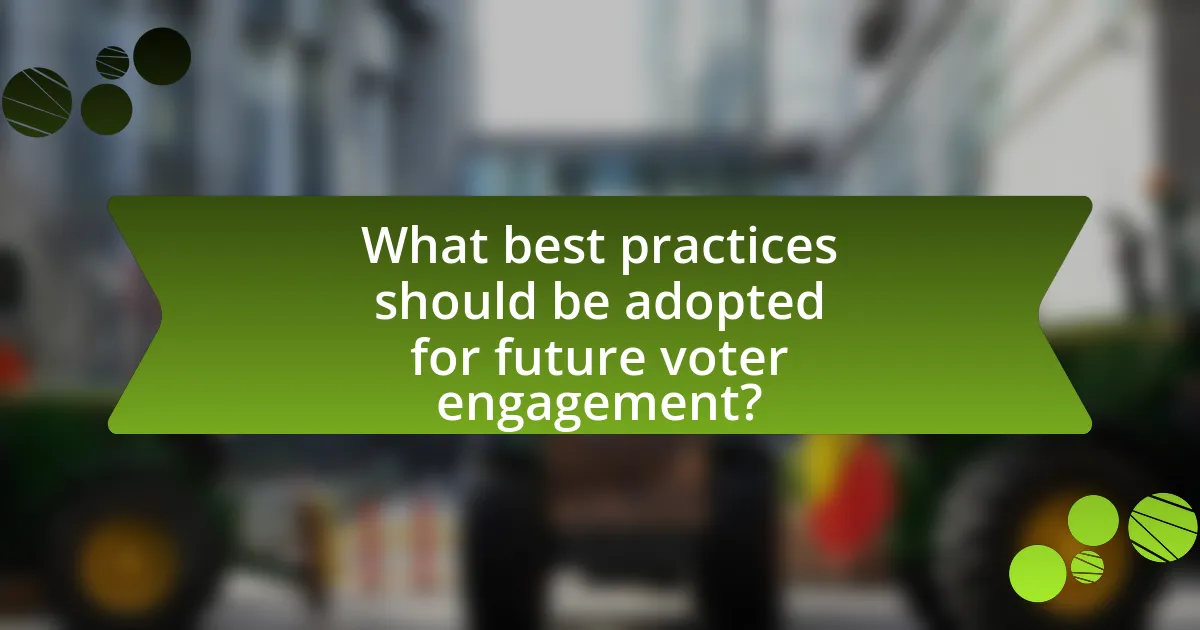
What best practices should be adopted for future voter engagement?
To enhance future voter engagement, adopting a multi-channel communication strategy is essential. This approach ensures that information reaches diverse demographics through various platforms, including social media, email, and traditional media. Research indicates that utilizing multiple channels increases voter awareness and participation; for instance, a study by the Pew Research Center found that 53% of voters aged 18-29 reported being influenced by social media in their voting decisions during the 2020 election. Additionally, implementing targeted outreach programs that focus on underrepresented communities can significantly improve engagement. Data from the U.S. Census Bureau shows that voter turnout among minority groups increased when tailored outreach efforts were employed. Therefore, a combination of multi-channel communication and targeted outreach is crucial for effective voter engagement in the future.
How can organizations ensure inclusivity in voter engagement efforts?
Organizations can ensure inclusivity in voter engagement efforts by implementing targeted outreach strategies that address the diverse needs of various communities. This includes utilizing multilingual materials to reach non-English speakers, partnering with local organizations to understand specific community concerns, and employing accessible technology to engage individuals with disabilities. Research indicates that inclusive voter engagement can increase participation rates; for example, the U.S. Census Bureau reported that voter turnout among minority groups improved significantly when tailored outreach was employed during elections. By focusing on these strategies, organizations can create a more equitable voting environment that encourages participation from all demographic groups.
What strategies can be implemented to reach underrepresented communities?
To effectively reach underrepresented communities, targeted outreach strategies must be implemented, including partnerships with local organizations, culturally relevant messaging, and the use of technology for engagement. Research indicates that collaboration with trusted community leaders enhances credibility and fosters participation; for instance, a study by the Pew Research Center found that community-based organizations significantly increase voter turnout among marginalized groups. Additionally, utilizing social media platforms and mobile applications can facilitate access to information and resources, as demonstrated by the success of initiatives like Rock the Vote, which effectively mobilized young voters through digital channels.
How can feedback from voters be effectively incorporated into engagement strategies?
Feedback from voters can be effectively incorporated into engagement strategies by utilizing structured surveys and focus groups to gather insights on voter preferences and concerns. These methods allow organizations to collect specific data on what voters value, which can then inform tailored communication and outreach efforts. For instance, a study by the Pew Research Center found that 70% of voters appreciate when their opinions are considered in decision-making processes, indicating that incorporating feedback can enhance voter trust and participation. By analyzing this feedback, engagement strategies can be adjusted to address the specific needs and interests of the electorate, ultimately leading to more effective voter mobilization and satisfaction.
What practical steps can individuals take to enhance voter engagement?
Individuals can enhance voter engagement by actively participating in local community events and discussions about voting. Engaging in these activities fosters awareness and encourages others to consider their voting responsibilities. Research indicates that community involvement significantly increases voter turnout; for instance, a study by the U.S. Census Bureau found that individuals who discussed politics with friends and family were more likely to vote. Additionally, individuals can utilize social media platforms to share information about upcoming elections, deadlines, and the importance of voting, which can reach a wider audience and motivate peers to participate.
How can citizens advocate for better voter engagement practices in their communities?
Citizens can advocate for better voter engagement practices in their communities by organizing local initiatives that promote awareness and accessibility of the voting process. For instance, they can establish community forums to educate residents about voting rights, deadlines, and methods, which can significantly increase participation rates. Research from the U.S. Census Bureau indicates that voter turnout can increase by up to 20% when communities actively engage in outreach efforts. Additionally, citizens can collaborate with local organizations to create voter registration drives, ensuring that underrepresented populations have the resources and support needed to participate in elections.
What resources are available for individuals to educate themselves and others about voting?
Individuals can educate themselves and others about voting through various resources such as online platforms, educational organizations, and government websites. Websites like Vote.org and CanIVote.org provide comprehensive information on voter registration, polling locations, and voting procedures. Additionally, organizations like the League of Women Voters offer nonpartisan resources, including voter guides and educational materials that explain the voting process and issues on the ballot. Government websites, such as those maintained by the U.S. Election Assistance Commission, provide official information on voting laws and regulations. These resources collectively empower individuals to understand their voting rights and responsibilities, thereby enhancing voter engagement.
